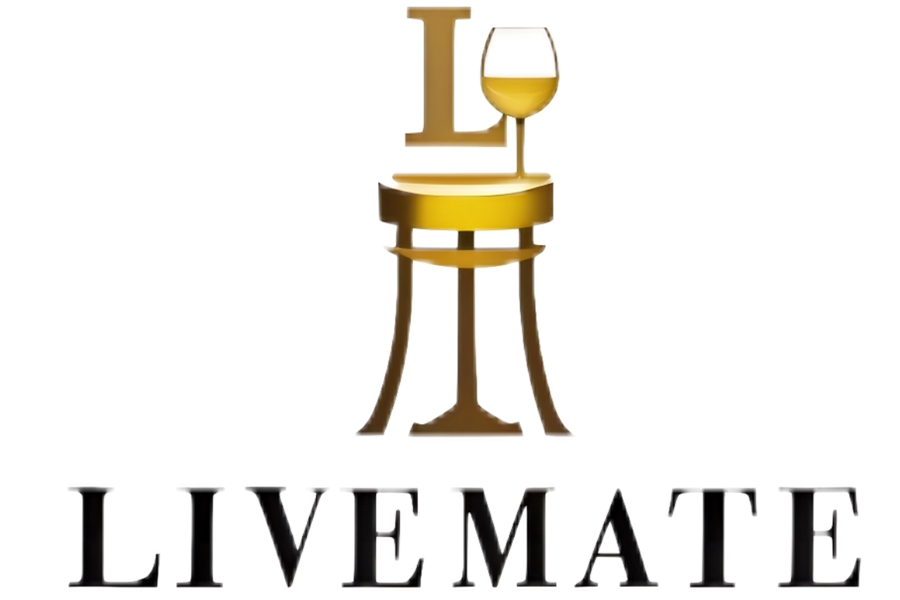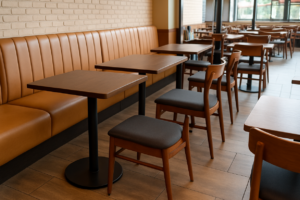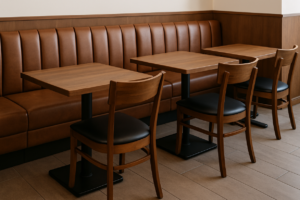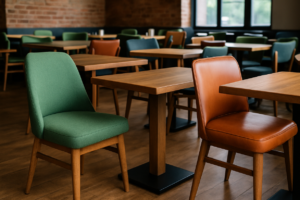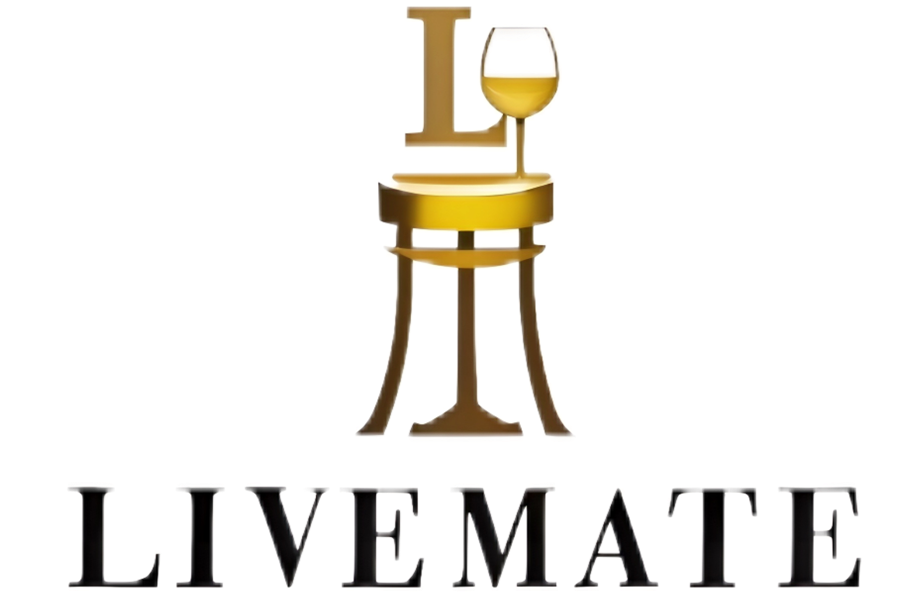Unsure how much space restaurant booths require? You don’t want them too cramped or taking up valuable room. I’ll break down standard dimensions and how to calculate booth size.
The standard size of a restaurant booth is typically 48 inches deep and 42-48 inches wide per seat. This allows comfortable space for diners and adequate room for traffic flow.
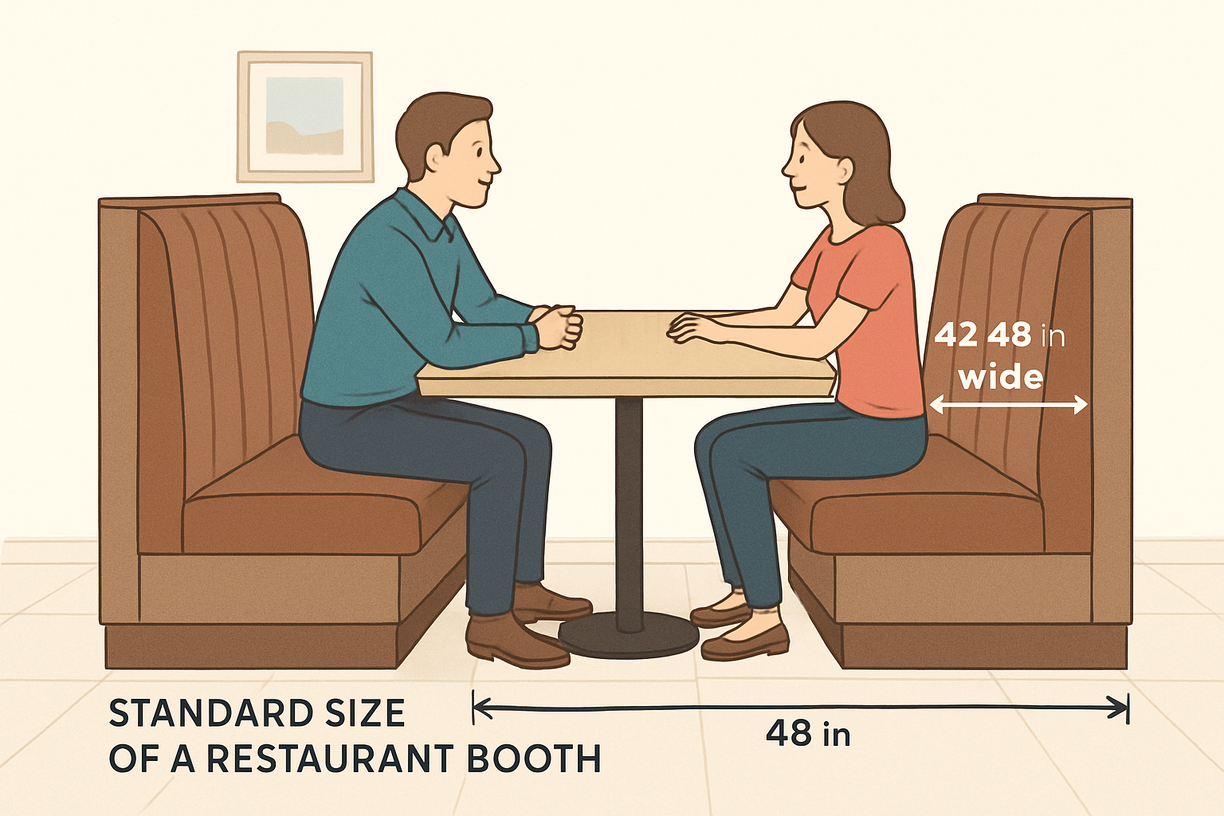
Getting the booth dimensions right is key. Too small, and customers are uncomfortable. Too big, and you lose valuable floor space. Let’s get into the details.
What is the Standard Size of a Restaurant Booth?
What exactly is considered the "standard" size for a restaurant booth? There’s no one-size-fits-all answer, but some sizes are more common than others. Let’s look at the most typical dimensions used in the industry.
A standard restaurant booth is usually around 48 inches (4 feet) deep, measured from the front edge of the seat to the back of the booth. The width per person typically ranges from 24 to 30 inches, so a booth for two people would be 48-60 inches wide.
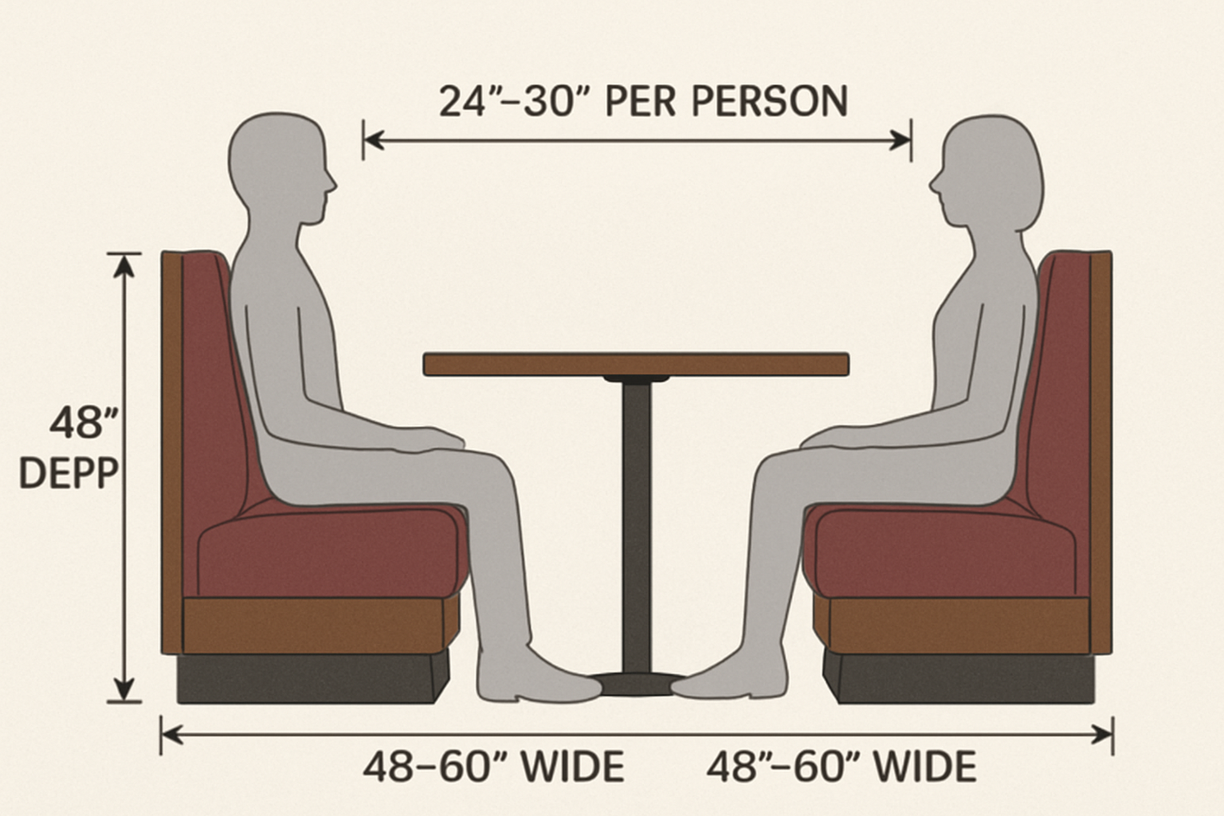
These measurements are designed to provide a comfortable dining experience1 while maximizing space efficiency2. The depth allows enough room for diners to lean back comfortably, and the width ensures each person has adequate personal space. Of course, these are just guidelines. You might need to adjust the dimensions based on your specific needs and the overall design of your restaurant. For example, if you want to create a more luxurious and spacious feel, you could increase the depth and width of your booths.
Here’s a summary of standard dimensions:
| Dimension | Size | Notes |
|---|---|---|
| Depth | 48 inches (4 feet) | Measured from the front of the seat to the back of the booth. |
| Width | 24-30 inches per person | Varies depending on the desired level of spaciousness. |
| Height | Typically 36-48 inches | Can vary based on design, higher backs offer more privacy. |
| Table Height | Usually 30 inches | Standard table height to ensure comfortable dining. |
When planning booth layouts, I always consider the aisle space around the booths. You need enough room for servers and customers to move around comfortably.
What is the Average Booth Size?
What’s the average size we see most often in restaurants? Knowing the average helps set a baseline for your own planning. Let’s pinpoint what’s most commonly used in the industry.
The average booth size typically accommodates four people and measures approximately 48 inches deep by 48-60 inches wide. This provides a balance of comfort and space efficiency for most restaurants.
This "average" size works well for many restaurants because it can accommodate families, couples, or small groups of friends. It’s a versatile option that fits into various restaurant layouts3. Keep in mind that you can customize booth sizes4 to suit your specific needs. If you cater to larger groups, you might want to include some larger booths in your design. Conversely, if you have limited space, you could opt for smaller, two-person booths.
Here’s a breakdown of booth sizes based on seating capacity:
| Seating Capacity | Width (approximate) | Depth (approximate) |
|---|---|---|
| 2 people | 48-60 inches | 48 inches |
| 4 people | 48-60 inches | 48 inches |
| 6 people | 72-90 inches | 48 inches |
I’ve found that having a mix of booth sizes is a good strategy. It allows you to accommodate different group sizes and maximize your seating capacity.
What Are the Dimensions of a Booth Plan?
How do you translate booth dimensions into an actual floor plan? Agitation: It’s more than just knowing the size; it’s about how they fit in the space. Let’s discuss the key elements of a booth plan and how to visualize the layout.
A booth plan includes the booth’s depth, width, height, and the surrounding aisle space. It also shows the placement of the table and chairs (if applicable) within the booth. A good plan accounts for traffic flow and accessibility.
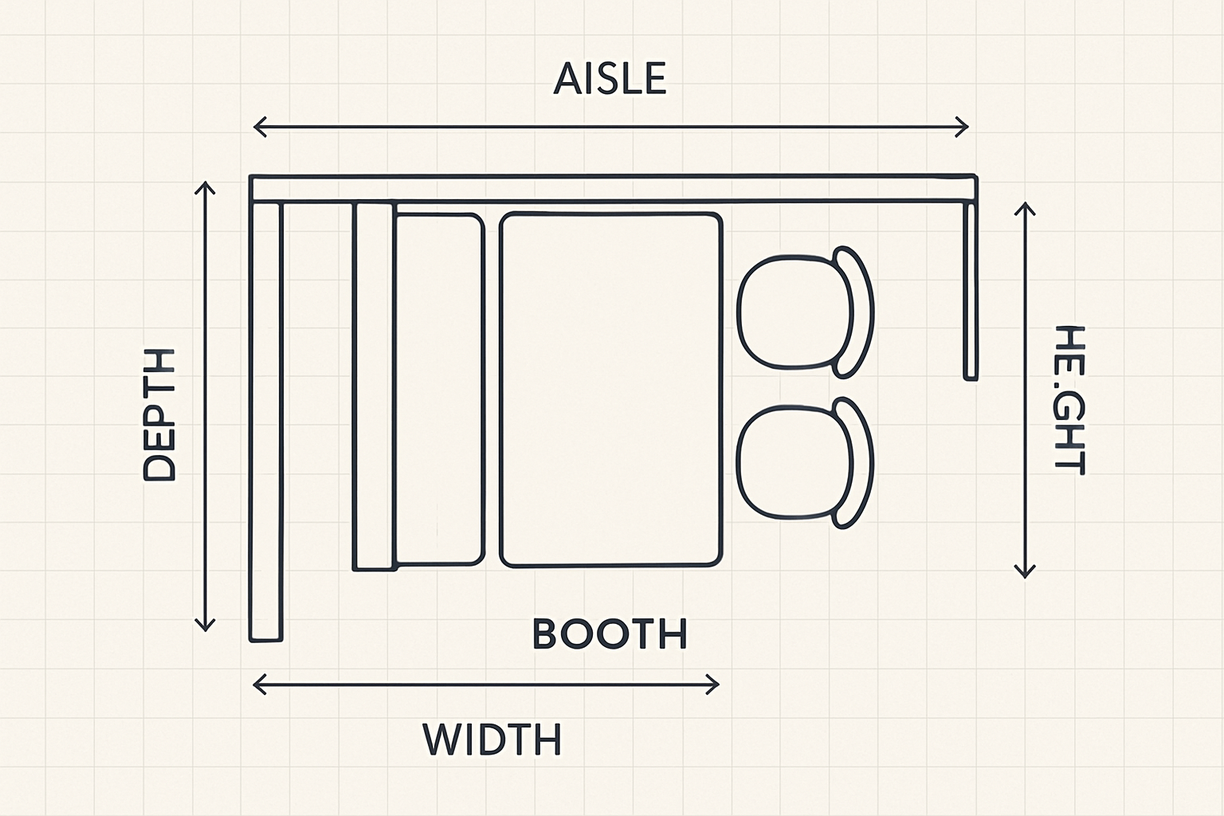
When creating a booth plan5, start by measuring your available space. Then, decide on the size and configuration of your booths. Consider the placement of doorways, windows, and other architectural features. Don’t forget to factor in the aisle space6 needed for servers and customers to move around comfortably. Aisle widths should be at least 36 inches, and preferably 48 inches or more. Use a CAD program or even graph paper to draw out your booth plan1. This will help you visualize the layout and identify any potential problems.
Key elements of a booth plan:
| Element | Description |
|---|---|
| Booth Dimensions | Depth, width, and height of the booth structure. |
| Table Dimensions | Size and shape of the table within the booth. |
| Aisle Space | Width of the walkways around the booth. |
| Seating Layout | Arrangement of seats within the booth. |
| Accessibility | Ensuring the booth is accessible to people with disabilities (ADA compliance). |
I always make sure to get feedback on my booth plans from both staff and customers. This helps me identify any potential issues and make sure the layout is functional and comfortable.
How to Calculate Booth Size?
How do you figure out the right booth size for your restaurant? Agitation: It’s a balancing act between comfort, space, and capacity. Let’s walk through the steps to calculate the ideal booth size for your needs.
To calculate booth size, start with the number of people you want to seat. Allocate 24-30 inches of width per person. Add 48 inches for the depth of the booth. Then, consider aisle space and overall restaurant layout.
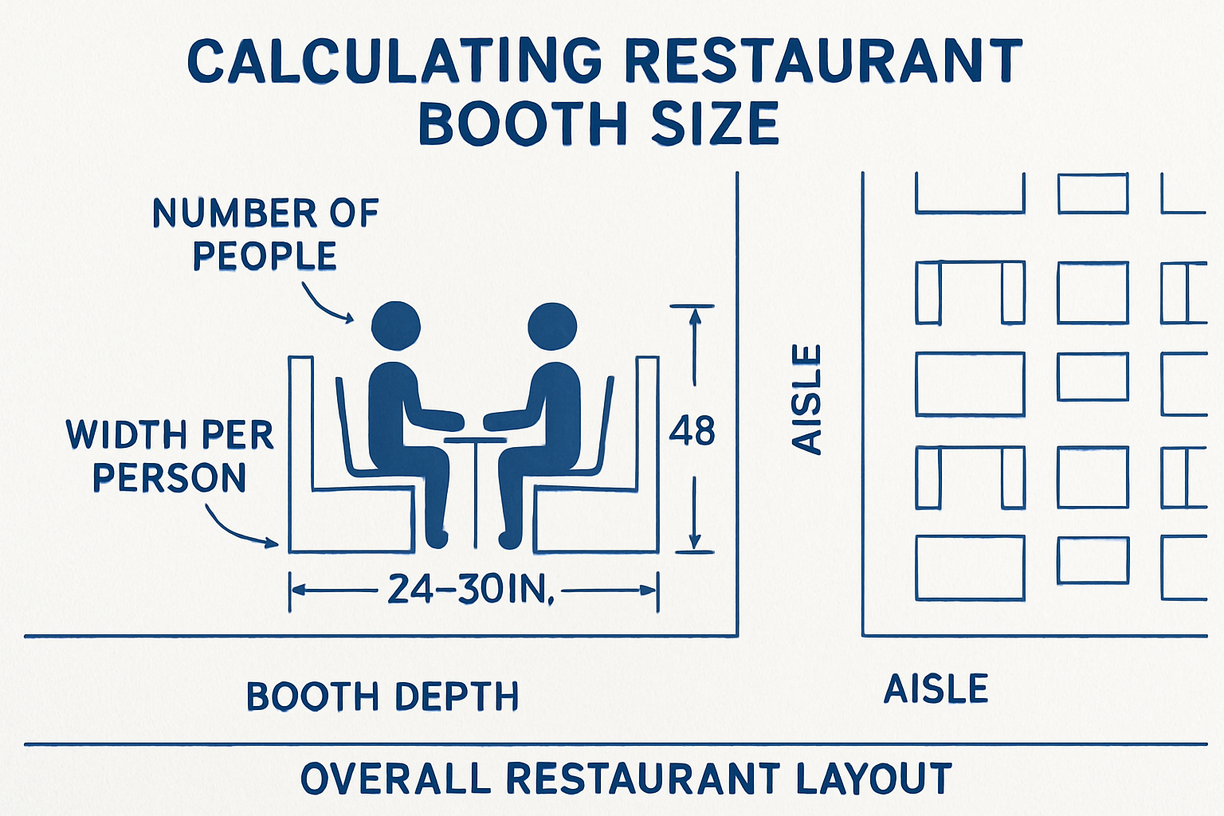
Here’s a step-by-step approach:
- Determine Seating Capacity: Decide how many people you want each booth to accommodate (e.g., 2, 4, or 6).
- Calculate Width: Multiply the number of people by 24-30 inches to get the total width. For example, a 4-person booth would be 96-120 inches wide.
- Set Depth: Standard booth depth is 48 inches.
- Aisle Space: Add at least 36-48 inches for aisle space around the booth.
- Consider Table Size: Ensure the table is appropriately sized for the booth and allows comfortable dining.
Here’s a simple formula:
Booth Width = (Number of People) x (24-30 inches)
Booth Depth = 48 inches
For example:
- A 2-person booth: Width = 48-60 inches, Depth = 48 inches
- A 4-person booth: Width = 96-120 inches, Depth = 48 inches
Remember to adjust these calculations based on your specific needs and the overall design of your restaurant.
Conclusion
Getting restaurant booth dimensions right takes careful planning. By following these guidelines, you can create a comfortable and efficient dining space for your customers.
-
Explore this link to discover expert tips and insights on enhancing the comfort of your dining space. ↩ ↩
-
This resource offers valuable strategies for optimizing space in your restaurant, ensuring a better layout and customer experience. ↩
-
Check out this resource for insights on designing restaurant layouts that maximize space and improve customer flow. ↩
-
Explore this link to discover optimal booth sizes that enhance customer experience and fit your restaurant layout. ↩
-
Explore this link to discover expert tips and strategies for designing an effective booth plan that maximizes your space. ↩
-
This resource will provide insights on optimal aisle space requirements to ensure smooth traffic flow and comfort for attendees. ↩
